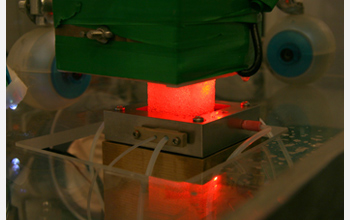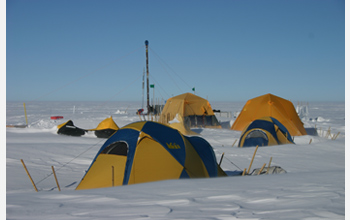All Images
News Release 08-142
Greenland Ice Core Reveals History of Pollution in the Arctic
Coal burning in Northern Hemisphere leaves potentially harmful heavy metal legacy
This material is available primarily for archival purposes. Telephone numbers or other contact information may be out of date; please see current contact information at media contacts.

Records taken from a Greenland ice core showed pollution from coal burning in North America and Europe that traveled through the atmosphere and deposited in the Arctic Region was higher 100 years ago, confounding researcher expectations that pollution was at its peak in the 1960s and '70s.
This image is of an ice core sample sitting on a melter head in the research facility. The longitudinal ice core sample falls by gravity onto the heated melter plate and the melt water split into three streams by grooves etched into the melter head. Only the inner most 10 percent of the melt water is used for ultra-trace elemental measurements. The middle 20 percent used for major ions and particle size determinations. The potentially contamined outer 70 percent of the melt water is discarded.
Credit: Joseph McConnell, Desert Research Institute
Download the high-resolution JPG version of the image. (768 KB)
Use your mouse to right-click (Mac users may need to Ctrl-click) the link above and choose the option that will save the file or target to your computer.
Joe McConnell discusses how coal burning in North America and Europe contributes to pollution in the Arctic. Pollution findings run counter to conventional wisdom, which held that toxic heavy metals in the region were higher in the 1960s and '70s.
Credit: National Science Foundation/Desert Research Institute

Detailed measurements from a Greenland ice core found toxic heavy metals primarily from coal burning in North America and Europe contaminated the polar regions after being transported through the atmosphere and deposited there. But the amount of contamination in the 1960s and '70s was less than researchers expected.
Credit: Joseph McConnell, Desert Research Institute
Download the high-resolution JPG version of the image. (2.4 MB)
Use your mouse to right-click (Mac users may need to Ctrl-click) the link above and choose the option that will save the file or target to your computer.


